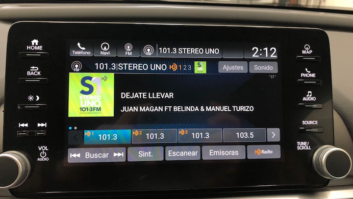Wheatstone’s Jeff Keith, Steve Dove and Mike Erickson have been busy in their Processing Cave at New Bern, N.C., and this time, they’ve targeted traditional analog FM with a unit that’s within the reach of most station budgets ($2,999 list). The FM-55 is a sweet-sounding processor with many of the features of its big brothers, including the top-of-the-line AirAura.
This is a five-band processor that isn’t dumbed down or stripped of key features. You can use the provided presets, or you can tweak like a madman (cackling all the while) to squeeze the last ounce of goodie from it. The provided GUI software is good, easy to use and intuitive.

Fig. 1: Front and rear panels of the Wheatstone FM-55.
It’s not a standalone FM+HD processor; all of the outputs have the same program. You can add up to 10 seconds of delay, but you’ll need a separate processor for the HD component.
But again, the FM-55 is targeted to analog FM. By eliminating HD radio-specific stuff (dual limiters, dual outputs and so on), they’re able to give a real bargain to the analog-only broadcaster.
FIRST IMPRESSION
The physical package is a single-rack unit with a solid feel. The Wheatstone pedigree shines through; the case feels rock-solid and the finish is resistant to scratches.
The front panel contains a full bank of LED meters, an OLED “smart” display, a jog wheel for adjustments and a “back” button. I found the controls easy to use.
The rear has six standard XLR 3-pin audio connectors. There are stereo analog ins and outs, as well as AES ins and outs. Four BNC connectors provide two SCA inputs and two MPX outputs, using the built-in stereo generator. The second multiplex output can be switched to provide only a 19 kHz pilot for syncing outboard equipment such as an RBDS generator.
The AES output supports the AES192 standard. If your exciter will accept a digital MPX input, you can feed composite-plus-subcarriers entirely in the digital domain.
You can select analog or digital inputs in the menu. With the latter, you can choose standard AES or WheatNet-IP. Automatic input failover is provided: If one input is lost, the FM-55 automatically will select the other within no more than 30 seconds.
As with most processing equipment, there is no power switch. I’ve finally gotten used to the idea of unplugging a processor to switch it off or reboot, but it still makes me itch. There are arguments for and against, though, so we can move on to more important matters.
Speaking of power, I recommend that you put the FM-55 on a good UPS. Not only will this protect the unit from power events, it needs a good bit of time to boot up (over 35 seconds in my tests).

Fig. 2: Using the stereo enhancement feature in the provided GUI.SWEET SPOT PART DEUX
Most Wheatstone processors nowadays have what’s called “Sweet Spot Technology” or SST. This is an intelligent algorithm that helps deal with different audio densities. The FM-55 has a newer version called iAGC, for “intelligent AGC.” This is exclusive to the FM-55 and, based on my tests with various source material, does a good job of maintaining a consistent sound.
The FM-55 also has the Bass Management System to correct for low-frequency intermodulation. I was impressed with the deep, rich and tight-sounding bass. You can use the GUI to tweak this to taste.
All in all, the processor sounds fabulous. The audio was clean and clear, with tight bass and sweet, silky highs.
It also uses Wheatstone’s standard approach to changing presets: The FM-55 “slews” (i.e., crossfades) from the old to the new smoothly over several seconds. Your listeners won’t be baffled and annoyed by abrupt changes when you’re experimenting with different presets.
MULTIPATH
This is by far the best feature, in my opinion; I’m not aware of another processor in this price range that allows you so much control.
First, a refresher. In the old days, with multipath, a typical receiver would simply toggle madly between stereo and mono (the stereo light would flicker). This was disconcerting to the listener. Newer receivers try to mask this by smoothly “blending” from stereo to mono. Unfortunately, with wide stereo separation, there is a perceived loss of volume and/or brightness when this occurs.
To help correct for this, many processors let you reduce the separation by some fixed amount (typically –3 dB or –6 dB). The downside, obviously, is that this reduces the total separation across the board and in all stereo receivers — including those that might be getting a strong, clean signal.

Fig. 3: The Multipath Limiter intelligently controls the L–R energy. The FM-55 addresses this by allowing you to enhance the separation within limits. You can boost the apparent separation at some frequencies, giving a dramatic spatial improvement at the listener’s ear. In Fig. 2, I’ve added 3 dB of enhancement to the mid-high frequencies, and have reduced the separation on the deep bass.
Normally, this would make “blending” sound even worse, but the FM-55 adds an intelligent multipath limiter (see Fig. 3). This limits the maximum L–R signal, never allowing it to “run away” or become excessive. Thus, material with average separation will be enhanced, but audio with lots of separation will be gently limited. The net result is a much less problematic “blend” effect on most stereo receivers.
One annoyance appeared when I was diddling with the multipath limiter. With most of these numerical values in the GUI, you can either use the up/down buttons, or you can click on the value and use an edit box to enter numbers manually. In this case, the edit box was labeled “dB” instead of percent, and it hated whatever I entered. It would reset to the previous value when I clicked “OK.” Not a big deal; I used the up and down buttons and moved on.
THE GUI
The free GUI software provided with the FM-55 is intended for Windows, but I discovered (with much joy!) that it would run perfectly in Linux on Wine. This may not mean anything to you, but it tells me that it’s written with well-known, reliable calls to the operating system.
I had to select “metering data over TCP/IP” in the GUI, probably because my network path was blocking the default metering. The GUI remained fast and responsive, even over a remote connection and with this option selected.
The layout is intuitive. You don’t just get the usual “click button, turn virtual knob” interface. The virtual sliders in the FM-55’s GUI are side by side. Real-time metering is overlaid on the sliders so you can see what your changes are doing.
Referring back to Fig. 2 — the top half shows the available control over the iAGC section. You can adjust the crossover frequencies and the coupling between bands. This is typical for the entire processor.
Because of the level of control provided, I suggest that you password-protect the unit and keep everyone else away from it. Otherwise, you’re likely to tune in one sunny morning and hear Sister Betty’s daily devotion sound like a Monster Truck commercial.
The manual describes each of these settings. If you’re not into tweaking, you can choose a preset, set your levels and you’re good to go. If you like to play and tweak and squeeze the last drop out of your processor, the FM-55 will let you do it.
Product Capsule
Wheatstone FM-55
FM Audio Processor
Thumbs Up
+ Sounds “absolutely delicious”
+ Well-built, rock-solid feel, rugged finish
+ Excellent, comprehensive GUI
+ Multipath correction with stereo enhancement at the same time
Thumbs Down
– No printed manual
– Needs a UPS: 30–40-second boot time
Price: $2,999
For information, contact Jay Tyler
at Wheatstone in North Carolina
at (252) 638-7000 or visit www.wheatstone.com.
SUMMARY
Truthfully, I haven’t been this impressed with a processor in a long time. The box is for those who love good audio, who love radio and who want loud but clean sounds. The fact that it lists for under $3,000 makes it even more amazing.
There were a few glitches.
I mentioned the issue with directly editing the multipath limit value in the GUI.
Also, the included manual is PDF only; there is no printed version. This is becoming common, of course, but old-timers like me would prefer a dead tree reference in our laps while we tweak.
Second, Wheatstone has always been a bit … geeky. I love ’em for it, but honestly, instead of devoting two or three pages to the correct way to make cables, I’d rather see more practical, real-world advice on how to tweak this thing for a given format and/or service area.
In particular and most especially, I’d rather have a nice, step-by-step and detailed walkthrough for the multipath limiter vs. the stereo enhancement. This is one of the FM-55’s strongest features and it only gets about a half-page’s worth in the manual.
But that really is a quibble. This is an excellent-sounding box. While it manifestly is not just for small-market stations, those folks, in particular, should immediately take a close look at this processor. For example, I can imagine a Class A broadcaster in a small town, 30 miles away from a city with several FMs. The “little guy” needs to compete, but can’t justify the $10,000–15,000 price of a top-flight processor. I can heartily and without reservation recommend the FM-55 to this broadcaster, especially if that FM is in a hilly area and struggles with multipath.
Stephen M. Poole, CBRE-AMD, is market chief engineer for the Crawford Broadcasting Co.’s five-station AM/FM cluster in Birmingham, Ala. He has over 30 years of experience with twirling knobs and making radio sound as good as it can.












